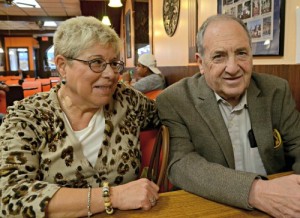In the 1970s, Stanton Ross owned Premier Jewelers, a shop along Mill Street in Bristol Borough, Bucks County. He had always sold the kind of jewelry you would expect to find: rings, necklaces, bracelets, broaches, watches. But he remembers the day when a young couple visited his shop with what, at the time, seemed like an usual request.
“They wanted Irish wedding bands. I didn’t have them, but I found them for them,” says Ross. “Before long, I started getting a lot of requests for them. People came from all over, and they told their friends.”
Ross recognized an opportunity. Before long, he was stocking wedding bands, Claddagh rings, and other Celtic-themed jewelry, and those items proved to be popular with people of a certain ethnic background. But soon selling Celtic gewgaws and tchotchkes became more than just business. It was the beginning of a beautiful relationship with the local Irish community.
”I was invited to plenty of weddings after that,” Ross recalls. “They were customers first, but then they became friends.”
One thing led to another. Ross’ casual interest in Ireland soon blossomed into a full-blown passion. Some people might think this level of interest is unusual for a man with no Irish blood in his veins. Ross is of Romanian heritage. But to meet him is to almost instantly know him for the intellectually curious man he is.
“I knew it was about a lot more than wedding rings,” says Ross. He’s 82, with a modest, soft-spoken demeanor. “I became interested in the Irish culture. I read books about it, and I visited the Balch Institute. (The Balch Institute for Ethnic Studies, at 1300 Locust Street, houses a vast collection of Irish manuscripts and other historical documents.) I went to Ireland several times. I visited Doolin and Lisdoonvarna (in County Clare), and Dublin. I visited Trinity College and saw the Book of Kells. I went to visit Derry and Belfast. I just wanted to see what it was all about.”
Here and there in his travels, Ross compared notes with local jewelers, but his interest in the Emerald Isle always transcended commercial concerns. “It just seemed like an interesting place. They had all the odds stacked against them for hundreds of years, and they survived. It inspired me.”
Ross continued to soak up all things Irish, even after he closed his shop in Bristol in 1988, and went on to work at Carver W. Reed & Co., a firm that makes low-interest collateral loans on fine jewelry—where they had precisely no interest in Irish jewelry. He retired from the business in June, but it didn’t take long for his partner Miriam Stamm and daughter Lori Iller to notice his restlessness.
At their gentle urging, Ross came out of his brief retirement to return, in a modest way, to what he loved: selling Irish jewelry. This time around, he was going to take charge of the operation, from sophisticated computer-aided design to finished product. All the help he needs to do his work, he can find along Sansom Street—Jeweler’s Row. From his long years in the business, Ross knows all the local artisans, tucked away the often claustrophobia-inducing back shops where they produce 3D wax models, create custom casts, and polish precious metals.
And Ross was going to take the plunge and sell online. The new company, with Stamm and Ross’s daughter as partners, is called Relik. It’s been in operation just three months.
“He had always wanted to do this,” Stamm says. “It just seemed like a good time to do it. So the three of us started the company. We thought the name ‘Relik’ would set us apart. We’ve been putting our own money into it. You make some money, and you put it back in. We’re trying to be as smart as we can about it. It was his dream, and that was what pushed us into it.”
Stamm, whose folks come from Germany, is also an ardent lover of all things Irish.
The small company produces a limited number of modestly priced pieces—10 to 15 a month, Stamm says. Some of them they sell on the website (designed by Iller); others they sell at local craft fairs and farmers markets, including the big one in Glenside, Montgomery County.
Most of Relik’s designs are familiar—Celtic Trinity Knots, shamrocks, St. Brigid’s Crosses—and of course, the ubiquitous Claddagh.
Other designs are a bit different—inspired, Ross says, by Irish artwork he’s seen in his travels, snapshots brought back from trips to Ireland, and occasional estate sale finds. One such recent discovery was a hand-made, gold-plated pin from the Victorian era. Unfortunately, that particular pin won’t be part of the Relik collection. “It wasn’t beautiful,” Ross laughs. “It was just interesting.”
Ross draws inspiration from all of those outside sources for one particular reason. He’s no designer. Still, he knows what he likes, and it keeps him interested and engaged.
“Artists, we’re not,” says Ross. “But there’s a lot of stuff out there. I never knew the Tree of Life was Irish. It’s amazing.”

